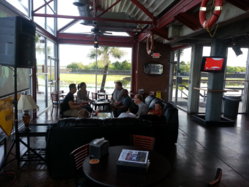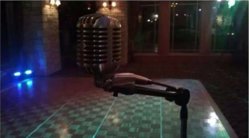OK, other than microphones picking up the amplified music, what could be some other causes of microphone feedback.
Feedback causes
- Thread starter Ron
- Start date
You are using an out of date browser. It may not display this or other websites correctly.
You should upgrade or use an alternative browser.
You should upgrade or use an alternative browser.
Feedback is a symptom of an unbalanced amplification chain ... some fundamental frequency (or frequencies), due to resonance, where the system causes an additive situation, keeps looping through, getting louder and louder until it squeals.
So, the things that affect it are the pickups (mics, guitar pickups, etc.), the relation of the pickups to the reproducers (speakers), the specific frequencies, the mic preamp gain, eq settings, and system gain.
Starting with the mic, you want to eliminate any sounds going in that it is not expected to reproduce. Then you want to make sure it is the correct type for the use (some types, notably condensers, feedback easier), pointed away from any speaker (not at it), is pointed away from reflective surfaces where sound could bounce off, and you keep monitors away from one of the mic lobes (they vary based on mic directivity).
Then you want the gain sufficient to bring up the mic to a consistent level .. assuming the singer is close enough to the mic. Riding the gain because someone is singing/talking too far from the capsule is another common cause.
EQ can help tame feedback frequencies,, but can also contribute to issues if the wrong frequencies are boosted.
There are so many parameters that can affect it .. the worst being usually a novice person on the mic .. holding against their chest, cupping the capsule, etc. .. all things that can cause feedback.
It's the primary reason I run a feedback eliminator on my mic channels. I have a Sabine single channel unit, a Sabine dual-channel, 3 Behringer Sharks (DSP110) and then there are the feedback reducers built into my DriveRacks. One of them is on.
If you get REALLY GOOD ... you might be able to identify the frequency of the feedback and cut it out with an EQ, but I'm just not that good.
So, the things that affect it are the pickups (mics, guitar pickups, etc.), the relation of the pickups to the reproducers (speakers), the specific frequencies, the mic preamp gain, eq settings, and system gain.
Starting with the mic, you want to eliminate any sounds going in that it is not expected to reproduce. Then you want to make sure it is the correct type for the use (some types, notably condensers, feedback easier), pointed away from any speaker (not at it), is pointed away from reflective surfaces where sound could bounce off, and you keep monitors away from one of the mic lobes (they vary based on mic directivity).
Then you want the gain sufficient to bring up the mic to a consistent level .. assuming the singer is close enough to the mic. Riding the gain because someone is singing/talking too far from the capsule is another common cause.
EQ can help tame feedback frequencies,, but can also contribute to issues if the wrong frequencies are boosted.
There are so many parameters that can affect it .. the worst being usually a novice person on the mic .. holding against their chest, cupping the capsule, etc. .. all things that can cause feedback.
It's the primary reason I run a feedback eliminator on my mic channels. I have a Sabine single channel unit, a Sabine dual-channel, 3 Behringer Sharks (DSP110) and then there are the feedback reducers built into my DriveRacks. One of them is on.
If you get REALLY GOOD ... you might be able to identify the frequency of the feedback and cut it out with an EQ, but I'm just not that good.
Here are some pics of the venue.Ron .. were you getting feedback at a gig?
In the first one you can see where people are are singing and how behind them is glass.

The one below is slightly panned right of the singers. This is about the middle of the bar/ If I did a 180 I am about the same distance from another all glass wall.

This one is a view of the bar from where the singers are.

The glass can come into play if the mic gains are too high .. also getting the speakers a little further in front can help. The singers are hand holding the mics which means they probably end up pointing them at the speakers as they move around, which doesn't help and one is holding it against her chest, also a no no.
Try pushing the speakers forward a foot or 2 and putting the mics on stands and clamp them down .. might help. Getting the speakers up a little higher might help as well.
Try pushing the speakers forward a foot or 2 and putting the mics on stands and clamp them down .. might help. Getting the speakers up a little higher might help as well.
Looking at the 1st or 2nd photo the other speaker is about 10 - 12 feet behind me, giving them a good spread of about 25 ft.How many speakers were you using? If two, where is the other one located?
The problem is most karaoke singers like to hold the mics vs singing with them on a stand. I can certainly bump up the speaker height, but was concerned about the sound bouncing back because of the ceiling shape. If you look in the 2nd photo you can see the ceiling curve down a good bit to about 10 ft.The glass can come into play if the mic gains are too high .. also getting the speakers a little further in front can help. The singers are hand holding the mics which means they probably end up pointing them at the speakers as they move around, which doesn't help and one is holding it against her chest, also a no no.
Try pushing the speakers forward a foot or 2 and putting the mics on stands and clamp them down .. might help. Getting the speakers up a little higher might help as well.
So they are along the same plane/wall, right?
After "ringing" out the room, I rarely have issues with this, my Main Karaoke Mic. You should contemplate getting one. It has great Pickup for Voice. Better than my Shure SM 58.

However if you do, you may want to attach it to a Mini Boom (They are too heavy for Goosenecks)


After "ringing" out the room, I rarely have issues with this, my Main Karaoke Mic. You should contemplate getting one. It has great Pickup for Voice. Better than my Shure SM 58.

However if you do, you may want to attach it to a Mini Boom (They are too heavy for Goosenecks)


Last edited:
The problem is most karaoke singers like to hold the mics vs singing with them on a stand. I can certainly bump up the speaker height, but was concerned about the sound bouncing back because of the ceiling shape. If you look in the 2nd photo you can see the ceiling curve down a good bit to about 10 ft.
I agree, but if you're stuck with a glass wall behind and speakers close to the singers, sometimes it's the only way to control what the singers do.
If you can't, that setup is a perfect candidate for a feedback reducer. Ideally you want it on just the mics, but with a DJ type mixer, you can put one on the mixer output and clear it so often. I like the dbx AFS, the Sabine line, and the Behringer's are decent .. didn't have as much luck with the Peavey Feedback Ferret.
Also, make sure your mics are cardioid and not omni-directional.
Ron,
Are you using a Live Mixer and a DJ Mixer? If so, it is better to plug the DJ Mixer into the Live Mixer. Depending on the Live Mixer, most have better preamps than DJ Mixers anyway.
Are you using a Live Mixer and a DJ Mixer? If so, it is better to plug the DJ Mixer into the Live Mixer. Depending on the Live Mixer, most have better preamps than DJ Mixers anyway.
Using a DJ MixerRon,
Are you using a Live Mixer and a DJ Mixer? If so, it is better to plug the DJ Mixer into the Live Mixer. Depending on the Live Mixer, most have better preamps than DJ Mixers anyway.
Dunno if this will be feasible for you but I'll offer it.
Compression/limiting can make a world of difference in taming mic feedback. On the recommendation of live sound folks I put a C/L in the processing rack. We used to tussle with feedback ring but never had it happen again after that.
And we had some shows where it would have happened... vocalists and speakers walking in front of the stacks was the worst. But there was no feedback.
Most folks think of C/Ls as live sound gear and they are. Remember, a mic is live sound. I wouldn't be without a C/L in the rack.
Compression/limiting can make a world of difference in taming mic feedback. On the recommendation of live sound folks I put a C/L in the processing rack. We used to tussle with feedback ring but never had it happen again after that.
And we had some shows where it would have happened... vocalists and speakers walking in front of the stacks was the worst. But there was no feedback.
Most folks think of C/Ls as live sound gear and they are. Remember, a mic is live sound. I wouldn't be without a C/L in the rack.
I really would recommend you get a Live Mixer when doing Karaoke. You can adjust each mic individually and use more Mics, That may be another reason why your sound is so prone to feedback. You can add effects and set limiter gains on the Live Mixer. You can do so much more with a Live Mixer, including using a Mono Send for a single speaker to be used as a Monitor. This below is what I use. About two years ago upon the recommendation of Steve, I purchased this and have never regretted it. My Prior Live Mixer was a Mackie VLZ 1402 Here is mine.Using a DJ Mixer



